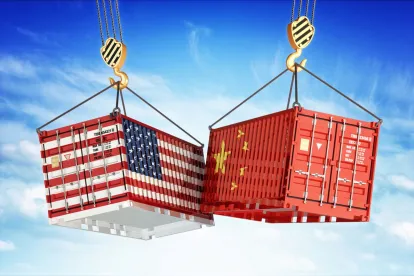On August 9, 2023, the Biden Administration took the first significant steps towards implementing a new regime to restrict and regulate U.S. investments in certain Chinese technology sectors. The President released an Executive Order (“EO”) alongside an Advance Notice of Proposed Rulemaking (“ANPRM”) by the Department of the Treasury (“Treasury”) that provides a framework for the U.S. Government to prohibit, or require notification of, U.S. investment into Chinese entities engaged in certain activities relating to: (1) semiconductors and microelectronics; (2) quantum information technologies; and (3) artificial intelligence (“AI”) systems.
Comments on the ANPRM are due September 28, 2023, after which Treasury will publish draft regulations.
Executive Order
In the introductory language to the new EO on “Addressing United States Investments in Certain National Security Technologies and Products in Countries of Concern,” President Biden states that “countries of concern” are engaged in long-term strategies to acquire and advance certain technologies that support their military, intelligence, surveillance, and cyber-enabled capabilities. The EO identifies these strategies as a threat to the national security of the U.S. The EO goes on to describe how countries of concern are exploiting the benefits of U.S. outbound investment in those technologies sectors, which, in addition to capital, often includes the intangible benefits such as “enhanced standing and prominence, managerial assistance, investment and talent networks, market access, and enhanced access to additional financing.” While the EO acknowledges that the open global flow of capital is a key aspect of U.S. policy, it identifies the critical nature of certain national security concerns as requiring regulation of outbound investments in these areas.
The EO directs Treasury to issue regulations defining two types of outbound investments in the three industry sectors: (1) those that are prohibited; and (2) those that require notification to Treasury. The EO also provides high-level definitions for certain of the key terms. Of particular note:
- Countries of Concern are defined as those countries listed in Annex A to the EO. The initial country of concern identified in Annex A is China, along with the special administrative regions of Hong Kong and Macau.
- A Covered Foreign Person, in which investment will be either prohibited or notifiable, is defined as a Person of a Country of Concern that is engaging in “activities” (to be defined by the regulations) relating to Covered National Security Technologies and Products.
- Covered National Security Technologies and Products are the technologies and products that will be defined by the new regulations in the three critical national security areas: (1) semiconductors and microelectronics; (2) quantum information technologies; and (3) AI systems.
- A Person of a Country of Concern includes (1) citizens and permanent residents of a country of concern who are not U.S. persons; (2) an entity organized under the laws of, or having a principal place of business, in a country of concern; (3) the government of a country of concern (including all subdivisions), or a person or entity owned, controlled, directed by, or acting on behalf of such a government; and (4) any entity owned by any of the persons identified in (1)-(3).
- For the purpose of identifying the people and entities that will be subject to the new regulations, a U.S. Person means U.S. citizens and permanent residents, wherever located, any entity organized under U.S. law (including all foreign branches of such entity), and any person in the U.S.
Treasury ANPRM
Simultaneously with the EO, Treasury released the ANPRM1 to provide further details regarding the Administration’s current thinking on the new regime and solicit comments from the public. In a Fact Sheet accompanying the ANPRM, Treasury notes that U.S. laws already prohibit or restrict the export of many of the technologies covered by the new regime to China. The purpose of restrictions on U.S. investments in those sectors is to prevent “helping accelerate the indigenization of these technologies in the PRC.” Unlike the inbound foreign investment review process administered by the Committee on Foreign Investment in the United States, Treasury noted that it does not contemplate the new outbound investment program would entail a case-by-case review process of U.S. outbound investments. Rather, Treasury expects the transaction parties to have the obligation to determine whether a transaction is prohibited, subject to notification, or permissible without notification.
The ANPRM seeks comment on a number of areas where Treasury intends to further elaborate on the definitions in the EO in its future draft rule. Provisions of note include:
- With respect to a Covered Foreign Person, Treasury is considering elaborating on the EO’s definition, to cover as follows:
(1) a person of a country of concern that is engaged in, or a person of a country of concern that a U.S. person knows or should know will be engaged in, an identified activity with respect to a covered national security technology or product; or (2) a person whose direct or indirect subsidiaries or branches are referenced in item (1) and which, individually or in the aggregate, comprise more than 50 percent of that person’s consolidated revenue, net income, capital expenditure, or operating expenses.
Among other input, Treasury is seeking public comment on the unintended consequences of such a definition, including the likely impact on U.S. investment flows and investment flows from third countries.
- Treasury is considering the following definition for Covered Transaction, which will trigger the prohibition or notification requirements of the new regulations:
a U.S. person’s direct or indirect (1) acquisition of an equity interest or contingent equity interest in a covered foreign person; (2) provision of debt financing to a covered foreign person where such debt financing is convertible to an equity interest; (3) greenfield investment that could result in the establishment of a covered foreign person; or (4) establishment of a joint venture, wherever located, that is formed with a covered foreign person or could result in the establishment of a covered foreign person.
Treasury further notes that it is considering included “indirect transactions” within the scope of Covered Transactions to reach investment that could be used to evade the new rules, including investing through a third-country entity.
Treasury also identifies the following transactions and activities that it does not intend to include within the definition of Covered Transactions: “university-to-university research collaborations; contractual arrangements or the procurement of material inputs for any of the covered national security technologies or products (such as raw materials); intellectual property licensing arrangements; bank lending; the processing, clearing, or sending of payments by a bank; underwriting services; debt rating services; prime brokerage; global custody; equity research or analysis; or other services secondary to a transaction.”
- Treasury also discusses its intent to identify Excepted Transactions, which will not trigger the requirements of the new rules. The definition of Excepted Transactions that Treasury is considering would exclude from coverage: (1) investments (a) into publicly-traded securities, (b) into index funds, mutual funds, and other similar instruments, or (c) made as a limited partner, under certain circumstances; (2) acquisitions of an entity, or all of the assets of an entity, located outside of a Country of Concern; (3) an intracompany transfer of funds from a U.S. parent company to a subsidiary; and (4) a transaction pursuant to a binding, uncalled capital commitment entered into before the issuance of the EO.
- Treasury provides extensive definitions that it is considering for each of the three Covered National Security Technologies and Products categories. In addition to the specific technology elements included under each category, the ANPRM defines the activities with respect to each category that will trigger coverage under the rules. Those definitions are too detailed to summarize here and should be reviewed carefully by U.S. persons that engage in investment in Chinese entities operating in technology sectors. Treasury is seeking feedback on the specifics and potential consequences of each of the definitions. Within the semiconductors and microelectronics and AI systems categories, Treasury is considering defining classes of both prohibited and notifiable transactions. For the quantum information technologies category, Treasury is considering only a class of prohibited transactions.
We expect that the draft regulations, when issued by Treasury, will include some material changes to the ANPRM definitions and provisions that are based on feedback received from the public. We will monitor these developments carefully and provide updates in future Alerts.
[1] Treasury formally published the ANPRM in the Federal Register on August 14, 2023.
Viking Tao, Shareholder at Polsinelli’s Business Department, also contributed to this article.




 />i
/>i

